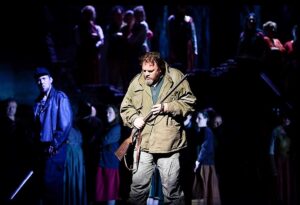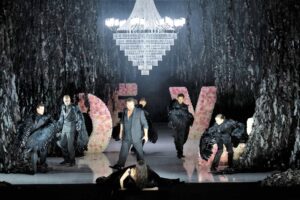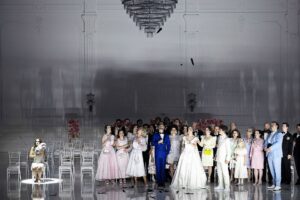During operatic holidays I no longer feel like discovering new lands. I prefer to return to places that bring back good memories: to trips to tried and tested theatres, to favourite works featuring reliable singers. So I planned both my July trips to Germany well in advance. My pretext for going to Dresden was Günther Groissböck’s appearance in the role of the demonic Caspar in Weber’s Der Freischütz – a little over a year after Kirill Serebrennikov’s bizarre and not entirely successful staging of the opera at Amsterdam’s De Nationale Opera with Groissböck in the cast. I travelled to Munich – unlike some of my colleagues who went there to see the new production of Semele directed by Claus Guth primarily because of Jakub Józef Orliński in the role of Athamas – to hear Jupiter as portrayed by Michael Spyres and to compare his interpretation with Jeremy Ovenden’s recent performance at the Göttingen Handel Festival.
I’ve written so much recently about Der Freischütz – admired not only by Chopin, but also by the young Zygmunt Krasiński, who reported to his father after the Warsaw premiere that the piece was “full of ghosts, monsters, bats, thunders, etc., etc., very much in the Romantic taste” – that I’ll get straight to the point. I saw the thirty-fifth performance of the staging, which has been in Dresden’s Semperoper repertoire for over eight years. Responsible for the direction is the Dresden-born countertenor Axel Köhler, who first tried his hand at the directing in 2000, thirteen years after making his debut in the part of Eustazio in Rinaldo, on the stage of the Staatstheater Halle. Since then he has directed more than fifty productions, while continuing his singing career and achieving notable successes as a teacher. His Freischütz gets rave reviews after each revival. This is hardly surprising – in a seemingly traditional production Köhler has managed to successfully move the action from the times of the Thirty Years’ War to a decidedly more recent period, with a conflict lurking somewhere in the distance, a conflict that only in the scene of the casting of bullets in Wolf’s Glen begins to evoke irresistible associations with the Second World War. However, there is no “for dummies” approach; instead there are monsters and thunders, there is a lot of laughter, even more emotion, and in the finale there is bright hope for redemption. Most significantly, however, Köhler – in perfect collaboration with the set designer Arne Walther and lighting director Fabio Antoci – has created a space that is extremely friendly to the singers, giving them not only vocal freedom, but also an opportunity to consciously use the tools of acting expression.
Der Freischütz, Dresden, 2015. Sara Jakubiak (Agathe) and Christina Landshamer (Ännchen). Photo: Matthias Creutziger
Such a clear and carefully thought-out concept facilitates the appreciation of the musical qualities of the production. The 2015 premiere was prepared by Christian Thielemann, who contributed to the subsequent success of the staging recorded on DVD. This season Antonello Manacorda took over the baton, leading the soloists and ensembles with a decidedly lighter hand, with verve, but not too excessive tempi, and above all with extraordinary attention to the variety of orchestral colours, emphasising the masterful dramatic structure of the work. He also had at his disposal a very even cast, the weakest link of which was, I regret to say, Groissböck, who sang forcefully, with intonationally uncertain phrasing, on the verge of audibility in the lower register and with an ugly, dull sound at the top of the range. Judging from the Austrian artist’s recent performances, his voice is beginning to betray the first signs of fatigue. Perhaps this could be remedied, for example by a more prudent choice of roles: the part of Caspar, however, requires a different kind of bass, with a bigger volume and more demonic colour. A much better impression was made by Stanislas de Barbeyrac as Max. He is a singer possessing the truest “French” lirico spinto tenor, with a beautiful golden tone and the makings of a great old-style dramatic voice. The only thing he could have done better in the Dresden performance was to have paced himself more wisely: after a very well sung Act I (excellent rendition of the aria “Durch die Wälder, durch die Auen”), he lacked energy in the Wolf’s Glen scene, but fortunately regained his form in the finale. Of the two performers of the main female roles, I was more impressed by Nikola Hillebrand (Ännchen), who has a warm, perfectly controlled, rich voice that may soon develop into a beautiful jugendlich dramatischer Sopran. The youthful freedom, especially at the upper end of the range, was somewhat lacking in Johanna van Oostrum’s singing, but the artist nevertheless managed to create a sympathetic and touching character of Agathe. Among the singers in the supporting roles, special mention goes to Sebastian Wartig, whose round, dignified baritone was a perfect match for the part of the good Prince Ottokar.
Der Freischütz, Dresden, 2015. Michael König (Max). Photo: Matthias Creutziger
Der Freischütz was played to a packed audience, as is usual in Dresden, where spectators celebrate every performance of this opera – starting in 1985, when it was presented during the inauguration of the Semperoper, rebuilt after the war. There was a slightly different atmosphere at the summer festival organised under the aegis of the Bayerische Staatsoper, which has grown to become one of the most important theatre and music events in Europe. It attracts music lovers and the curious from all over the world, and at the same time does not get in the way of the Bayreuth and Salzburg Festivals, which start a little later. The programme of this year’s Münchner Opernfestspiele included Handel’s Semele in a co-production with the Metropolitan Opera, where it will be presented in November 2024. In Munich it was staged at the Prinzregententheater, more than three times smaller than the Met and built in 1900–1901 after a design modelled on that of the Bayreuth Festspielhaus. This is especially true of the amphitheatre-like auditorium – the exterior of the theatre, designed by Max Littmann, is more reminiscent of Gottfried Semper’s earlier, historicising buildings. Originally conceived as a Wagnerian theatre and opened with a production of Die Meistersinger, today the building is home to the Theaterakademie August Everding and a second stage of the Bavarian Opera, hosting concerts as well as performances of Baroque, twentieth-century and contemporary operas.
In Semele, prepared for this year’s festival, Claus Guth again analyses the motivation and behaviour of his characters from the perspective of modern psychology. He transforms the story of the Theban princess into a tale of her desperate attempt to break free from the glitz of the world around her, to transcend her own boundaries, to reach regions where a frenzied pursuit of happiness may end in failure and bring even more suffering. Semele pierces the wall between reality and the unknown with a few axe blows. She finds herself transported from an ice-cold, blinding white to an equally blinding black of the land of the subconscious and myth. The two worlds begin to intermingle, squeezing into a space that is not their own. At one point the audience is no longer certain of whether it is Semele who is trying to worm her way into Jupiter’s good graces, or whether the god is invading her world and ruthlessly cornering her. Black feathers – symbolizing Jupiter’s eagle – ooze through cracks in the white walls and ceiling like a thick, sticky lava. A crystal chandelier from “this” world illuminates the thick, sticky darkness on “the other” side. In the lieto fine reality only seemingly comes together. The scene is shrouded in semi-darkness, Semele sits alone in a chair away from everyone, in a shaft of white light, clutching in her arms a bundle of cloth – hiding the void left by Dionysus or the child that never was.
As usual, Guth’s concept can be debated, but it is hard to deny its suggestiveness, achieved thanks to – apart from the director’s mastery of his craft – Ramses Siegel’s choreography and, above all, Michael Levine’s set design, phenomenally lit by Michael Bauer. It’s been a long time since I saw such fathomless black and such cool, polar white on stage, both softened by a number of significant intermediate hues. The few comic elements – including Orliński’s breakdancing act, widely commented on in the media – seemed like ghastly hallucinations against this background.
Semele, Munich, 2023. Brenda Rae (Semele) and Michael Spyres (Jupiter). Photo: Monika Rittershaus
The musical assessment of the performance will not be so easy. First, this is because of the participation of regular Bayerische Staatsorchester musicians, whom even Gianluca Capuano was unable to inspire to play stylishly, with both the tone colour and clarity of Handel’s texture suffering as a result. I also have to admit that I was annoyed by the basso continuo group playing its part in the manner of a folk or janissary band, which I can tolerate only in Jordi Savall’s old recordings. Secondly – because of the decision to cast Brenda Rae in the title role. Rae’s is a soprano with a puny volume, excessively wide vibrato and a coloratura technique that leaves a lot to be desired. Fortunately, Rae made up for this with her excellent acting, for which the audience rewarded her with a true storm of applause.
The other soloists were at least fine, although there were no revelations. Michael Spyres as Jupiter outclassed Ovenden from the Göttingen Semele in every respect, singing with a tenor beautifully open at the top, seductively deep in the lower register, improvising very stylishly as much as he could – but I have the impression that this excellent singer is still looking for a métier for himself after the inevitable evolution of his voice towards spinto. Let’s hope he doesn’t lose his way in this search, being fully aware that the bravura roles in French grand opera are slowly beginning to elude him. The roles of Juno and Ino this time went to two singers, Emily d’Angelo and Nadezhda Karyazina, respectively. It was probably the right decision: both singers have magnificent, dense mezzo-sopranos with a truly contralto low register. However, they lack the ability to differentiate their interpretations – although in this respect Karyazina, who is almost a decade older, still compares favourably with her colleague. Philippe Sly, cast in the dual role of Cadmus and Somnus (the short role of the High Priest was sung by Milan Siljanov), impressed me particularly with his sensitive portrayal of Semele’s father.
Semele, Munich, 2023. Final scene. Photo: Monika Rittershaus
I have left Jakub Józef Orlinski for last, as his participation in this production involved not only daring directorial ideas, but also interesting musical solutions. Let’s start with the fact that Handel wrote the part of Athamas for a tenor, then rewrote it for the first performer, the countertenor Daniel Sullivan (who did not sing in falsetto, but in his own natural voice, with the full alto range). In addition, Handel removed the soprano part of Cupid in its entirety even before the premiere of the work. In modern productions the character of Cupid is often brought back – primarily for the heavenly beautiful aria “Come Zephyrs, come” – sometimes combined with the role of Iris. In Munich Orliński sang the role of Athamas in a truncated version, but in Act II got Cupid’s aria, which was transposed down and which Guth very cleverly integrated into the dramaturgy of the staging. What was the result? Well, with his angelic, honeyed voice Orliński did much better with Cupid’s aria than with the role of Athamas, in which his light countertenor often disappeared in the lower register and did not reveal all the harmonics in the middle range. Whatever motivated the producers of the staging, they went for a Solomonic decision in allowing Orliński to develop his acting talent in the role of Athamas and showcase the best of his vocal technique in an aria intended for a different voice type. It’s a pity that this intelligent solution has not been honestly commented on by either the creators of the production or most critics.
All in all, however, there is nothing to argue about. Both the Dresden Der Freischütz and the Munich Semele gave me at least a brief respite from the usual blandness of the summer opera season, artificially hyped up by the media as a feast for music lovers and theatre enthusiasts. It’s good to return to tried and tested places. It is good to be able to enjoy art that does not offend anyone’s aesthetic sensibilities and openly invites discussion.
Translated by: Anna Kijak




